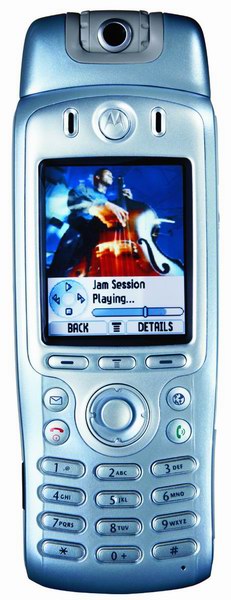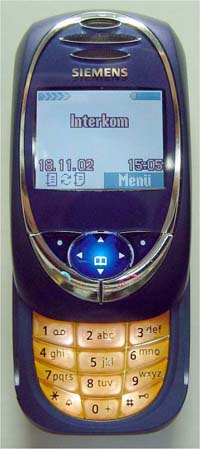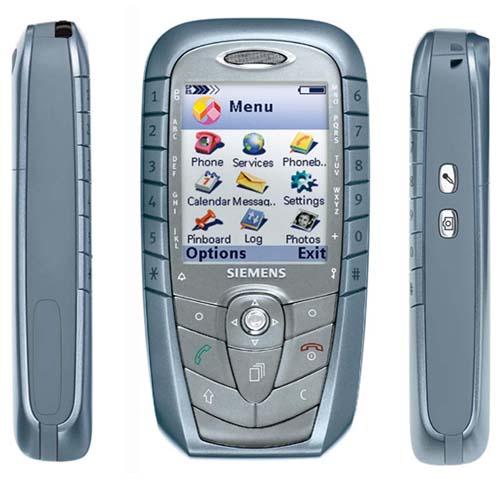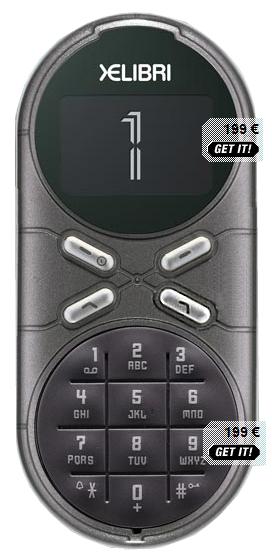Siemens – position in the market, analyses of the situation, new models
This year is crucial for Siemens’s mobile business; it would show whether those solutions, which the company made, were right or not. Many things depend on successfulness of new products and the company knows about it. The information concerning new models is too scarce and controversial. We doubt that detail specifications will appear before announcement. We can only assume how these models will be named and what features they will have. This article is only an analysis of various data. It shows our opinion on the current situation. We’ll speak mostly about general tendency of the company and not so much about separate models.
ÄFirstly, let’s remember the history and those, who create phones for Siemens. Today main sales in the middle and high price segments are provided by Siemens S55, SL55, M55. The similarity of these handsets, the fact that they have the same platform, is obvious.
However, the first model based on this platform – Siemens S55, was created due to Microcell and it is an ODM-model. Microcell is a small company. It is difficult for it to maintain many developers, who will create both hardware and software. In reality this company offers solutions based on licensed platforms from Ericsson. In particularly, Siemens S55 is created on the platform of this kind.
A small note about cooperation of Siemens and Ericsson was published in the end 2002 in the corporate newspaper of Ericsson – Contact. It was said that Microcell, which earlier licensed a platform from Ericsson, created a new solution for Siemens.
The same platform is used in such products as Sony Ericsson T68, T68i, T300, T310, T610. All rights for this platform belong to Ericsson. A joint enterprise Sony Ericsson has rights to use this solution. Details of this deal are not known; probably it was done on preferential terms because Sony Ericsson is a subsidiary company for Ericsson. Probably Ericsson took part in these developments too.
So, the situation is the following: all top models from Siemens are based on the platform, which belongs to the other company. Siemens wastes time and loses the race, as Sony Ericsson will have similar models earlier. However, it can offer more adjusted solutions. The announcement sounds logical, but in reality it is not so.
Let’s compare Siemens S55 and Sony Ericsson T68i. These phones are almost the same if compare them by features. They differ in software. Siemens changed it considerably, taking into account own necessities. We don’t know whether it was really necessary; may be it was one of the licensing conditions. But results were profitable. On the contrast to Sony Ericsson T68i Siemens S55 has improved work with MMS-messages. On the other hand, in the first versions of firmware Siemens had problems while working in 1900 MHz band. As a result, many Europeans who traveled to USA couldn’t use roaming. This problem doesn’t exist today.
One of the weaknesses of Siemens S55 is bluetooth realization. In first versions of firmware call transference from the phone to a headset was not comfortably realized. Later it became worse. It shows level of engineers, who face a new function and don’t have experience to work with such kind of products. Till now bluetooth function realization is weak in Siemens S55. Better to say that it is one of the most uncomfortable for using.
So, we can make a conclusion that engineers of the company facing new functions in new products (new platforms) are not always able to provide their fast and right support. Hence, later launching of products does not influence the quality of products. Handsets from Sony Ericsson and Siemens remain comparable. It means that these products mainly compete in prices, not technologies.
Few words about price formation from Siemens. Historically, the company firstly pays attention to products from Nokia and then forms its own offer. Remember opposition of Siemens S35 to Nokia 6210. During the whole life cycle Siemens was 25-35 USD cheaper than Nokia. An earlier launching of S45 made it one of the most popular business phones; delay of Nokia 6310 affects it greatly. It never reached a sales level of Nokia 6210. When Siemens and Nokia had similar product lines it was logically for Siemens to correct prices according to Nokia price policy. Everything was changed, when Nokia introduced a wide product range, which contained much more models. Now it is impossible to compare features of the phones in different price segments. As a result, price formation of Siemens is not always right.
Prices for phones made by Siemens went down faster than prices for Nokia’s handsets. It allows Siemens to support high sales of rather old models, but it demands replacement of these models in the future.
The main problem rises here. It’s not a secret that own new developments are rather expensive. Even such large companies as Siemens understand it. Not long ago Siemens dismissed some employees from several departments, including R&D. It was simpler to reduce costs due to hardware solutions of other companies. Delay in launching could be compensated firstly by original design and secondly – by the product’s price.
Once the company has already used platforms of other manufacturers, for example Siemens U10 – a handset of the third generation. It’s common knowledge that Motorola gave a license to use this platform. When I asked Rudi Lamprecht - Member of the Managing Board at Siemens, why they did it, he answered that they didn’t want to invent something new, they just took the best offer in the market. Siemens U10 has the same design as Motorola A820. The phone has only the other name of the company and color solution. The handsets has similar design as they both are produced at the same plant of Motorola in Germany. It is very convenient for Siemens. ON the one hand the company receives a complete product, on the other – it doesn’t use its own production lines.
 
Design from Siemens or a new tendency
Now few words about original design from Siemens. To some extent the company promoted pseudo-proof cases (Siemens M35, ME45), later similar handsets could also appear. There is a tendency that design of current models repeats old traditions. For example, Siemens SL55 has the same mode of open (sliding case) as Siemens SL10. Most users of mobile terminals do not remember this model, but it can be compared with Nokia 7650, which has the same system. Siemens assumed that Siemens SL55 would win due to original construction and small dimensions. Now it is not obvious what will be the future of this model, but we think that Siemens overestimated influence of design. They put attraction above phone’s ergonomics. It is not very comfortable to use the phone.

Producing M55, which is almost a cutting copy of Siemens S55 without IrDa and bluetooth, the company also concentrated on design. It is made in youth style: bright colors and blinking indicators. Ergonomics and nice design are combined in this model.
So, the main aim of the company in the near future will be to find new successful designs, which will attract attention of people. For example, they introduced Siemens SX1, which had a pleasant exterior but didn’t allow to input large volumes of information. As a result there is no sense for the targeted group (business users) to buy it. It is moved to a fashion segment, but the price of it is too high for this group. The other group of potential users is so-called Techie, those, who a found of all technical novelties on the market.

Later these design experiments will be widely spread; we’ll see unusual devices, which not always will have good ergonomics.
Once again about price formation and platforms of other companies
We’ve already mentioned that earlier Siemens paid attention to prices of Nokia, and then formed its own price policy. Now it is not so. Licensing one or another platform, Siemens correlates the rates with its price, price of software, warranty service and retail price of other rival products. A small example: there are two similar products in the market (Siemens S55 and Sony Ericsson T68i). What is necessary to do to increase sales of a new model? The right answer is promotion. So, the most influence will have marketing. Novelty plays a positive role but it can’t provide sufficient sales. The phone should be advertised. Besides, novelty (design, brand) allows taking extra money for it and a new phone will be more expensive (Siemens S55 is more expensive than Sony Ericsson T68i). Extra money allows covering advertising costs and warranty service.
It is necessary to understand that choosing of other manufacturers hardware is a right solution, as Siemens has a large market share in Europe. So, producing Siemens S55 the company almost doesn’t compete with Sony Ericsson T68i for the following reasons: both market shares of the companies and appeal of brands are considerably different. A priory Siemens could sale more phones of its trademark than Sony Ericsson, because Siemens has more users and higher brand awareness. Probably these reasons become the strongest while using the platform from Sony Ericsson.
Now let’s view pro and cons of using platforms of other makers and their influence on the end price of the product.
Development of the platform is rather expensive thing and undoubtedly, it is cheaper to buy it. Delay of launching plays negative role, but it can be compensated by different factors, and firstly the company has more freedom in positioning the phone in different price segments. Development of the own software will also demand extra charges.
Warranty service of own platform (better to say products based on own platform) is cheaper. Siemens had platforms, which enabled to repair the phone almost in each situation; very rarely a phone was replaced by another one. In case of using products from Sony Ericsson number of phones which should be replaced is higher.
Besides, if the phone is based on the platform of the other manufacturer and produced as ODM-product on the plant of the other maker, first months problems with components could arise.
Software is not always used all capabilities of the platform. You cannot note it on simple products but surely understand it studying more comprehensive handsets. Developers of software don’t spend time on studying this platform and its capabilities, though they don’t know it initially. As a result, quality of first versions of software is far from ideal. The example, which evidences partly difficulties with software, could be Siemens S55 and postponed launching of Siemens SX1. The company doesn’t change design (not much time is necessary for it). The delay is connected namely with the problems of the phone. Engineers can’t create a perfectly working smartphone during a short period of time, because it is also based on the platform of the other manufacturer.
There are also some more factors, but they play the second role. The main issue is a technological gap. When the company doesn’t develop own platforms, it couldn’t do it at all after some period of time, because it doesn’t have necessary staff. We think that Siemens lost its developers. During several years it has demonstrated elaborations of the future, which are never massively produced (phone-watch, screen combined with a loudspeaker etc.). Let’s see what the company has of its own today.
Own models and models of other manufacturers united in one product range
The company developed such handsets as Siemens A35, A40, A50, A55, C45, C55, M50, S45, ME45. Some models are not mentioned here (for example S45i), earlier lines are also missed, they are not so important.
Current product range includes such models as Siemens A50, A55, M50, C55, CL50, S55, M55, SL55. M50 is leaving the market. Siemens S45i, S45, ME45, C45 are also not actively sold now. So, main sales are provided by 7 models. Among them only 3 handsets (A50, A55, C55), which are positioned in the low-end or middle price bands, are developed by Siemens.
We’ve said that Siemens S55, SL55, M55 are based on platform from Ericsson. Siemens CL50 came from Asia, originally it was aimed to Asian market. But it was not successful there, probably because of compact dimensions of the phone. Asian users prefer larger handsets (Samsung understands it and satisfies demand). As a result, the model was re-targeted to European market. It is sold here only due to popular brand. The phone loses to its rivals by features. It’s interesting that Panasonic GD55 is based on the same platform; software of these handsets is almost the same. Both phones have identical features.
 
Among announced phones, Siemens SX1 is also based on the platform of other manufacturer (inside code name is K1).
Before describing future models, let’s see how demand in different price segments will change this year.
Decreasing of demand in the middle price segment
Correlation of different price segments is a question of vitally importance for manufacturers, because it allows planning number of produced phones of different classes. Siemens assumes that in the near future demand will be polarized, it will increase in the high and low-end segments and decrease in middle segment. Rudi Lamprecht also mentioned it.

This point of view is logical, but it is necessary to take into account several factors. It is possible to correlate different segments, if to estimate sales of terminals in the market, which doesn’t have subsides of operators. Russian market is an ideal example. According to Mobile Research Group, demand will move from middle price segment to high price band.

There will be stagnation in low-end segment (50-100$). So, the demand for phones which cost more than 200$ USD will increase and price group (100-200 $ USD) will be not so attractive for a potential buyer. Hence, sales of manufacturer will also decrease in this segment. Small offer in this segment will allow Siemens to make planned sales and keep it market share. However, the company could increase its market share only if it unveils new products in the >300 USD price segment. Remember, what we wrote about using of the platforms of other manufacturers. It is possible to overprice a handset and put a retail price, which will be more than 300 USD, but in this case the devices could not compete with other available products and their sales will fall down.
Xelibri series is a good example. These phones have scarce functionality and unusual exterior. You could find them in boutiques and they are very expensive. Xelibri line is positioned as expensive accessories. It is presumed that this collection will be changed two times in the year (8 phones in the year). First sales showed that the idea was not so interesting for end users. Users do not willingly pay 200 USD for the phone with scarce features. I can add that Xelibri series is developed on the platform of other maker and produced in Asia. Two models were born in Taiwan and two – in China. New collection will most likely elaborated there too.

So, Siemens will be able to keep its strong position in the low-end segment. Stable sales are expected to be in the middle segment, though taking into account reducing of demand, it is doubtfully that potential buyers will prefer Siemens to other manufacturers. The company doesn’t have offers in the high segment. So, optimistic estimation is that the company will keep it market share. But we think that Siemens will partly lose the market. It will have higher sales of terminals, but they will be behind the growth of the market.
The company could improve situation only if it launches new models in the high price segment, but it can’t be realized using platforms of other manufacturers. Let’s overview, which models the company will show in the near future.
New models from Siemens in 2003-2004
Siemens will concentrate on design, price formation and introductions of new models. Firstly let’s overview renewed products. It’s logical that soon we can see such phone as Siemens CL50i. The main difference of this handset is a color screen, which will support up to 4096 colors. You can know its specifications if read description of Panasonic G50. These phones differ only in form-factor.
The second model is Siemens S55i. It is also logical if it appears, because the similar renovation had Siemens S45. The screen will show up to 4096 colors (as Siemens SL55, M55), available memory pool will expand to 4Mb (total memory will be about 8Mb). We have no information about other differences, but they surely will be in software of the phone.
There are also no data about ÌÐ55, which is a copy of M55 with a changed design. There is a presumption that this phone will be officially announced in July in Moscow. At the same time other models, such as Ñ60, ÌÑ60 (code names - Magura, Fox) will be unveiled. They are targeted to youth market. We don’t have detail specification of these handsets, but we think that they will have much in common with M55. For the first time they will support MMS in this class.
Besides, product range will be widened due to introduction of the phones with integrated camera. In autumn Siemens will announce Siemens SL65 – the handset which is based on Siemens SL55. It will be equipped with VGA-camera, which will have standard capabilities.
There are rumors about several models equipped with integrated cameras. One if them is CL60, which won’t be a clamshell phone, and which will be based on the same platform as M55. It is said about a several models of CL series, but it is too early to make forecasts.
Low-end segment will include A60 (cutting version of C60) in the end of the 3Q 2003. At the same time A50 would leave the market. May be simultaneously Siemens will announce a new business phone - Siemens S65. In our opinion it will be a similar model to Sony Ericsson T610 with expanded memory and several software changes.
In the middle of the year we can see Siemens SX2 (code name – K2). It is too early to speak about specifications of this smartphone, but it is known that the company is going to equipped the model with 262K touch screen. Besides, it will have an integrated 1-Megapixel camera and support video records. It is useless to speak about memory size now. Prices can fall down and in this case it will be increased. According to current information the phone will have 64Mb of memory, which can be used to keep data, and 16Mb for OS (Symbian 7).
Small conclusion
Siemens decided to refuse from own developments of phones. The last own business phone elaborated by this company was Siemens S45. From that time onward the company has used hardware solutions of other manufactures, develops its own software and design. Siemens sells its phones due to high brand awareness and good marketing policy. It’s not bad, but it will be very difficult and too expensive to begin creation of own platforms. The company will depend on suppliers and every year the situation will be worse. Any wrong solution and unsuccessful product will influence position of the company. Today Siemens has nothing except brand and trademark, which it successfully used.
Doubtfully that image of the company will change in the near future. This process will be gradual. However, this year Siemens would lose its market share (both in Europe and Russia).
At last few words about traditions of stags. During two last years (by the first of October) have appeared rumors that Siemens and Motorola are going to create a joint enterprise to produce mobile phones. These rumors have no evidences, but they arouse great interest. We think that this year won’t be an exception and somebody once again will discuss it to for the sake of speculation. Most people have short memory. It means that soon we’ll hear debase about advantages and disadvantages of such unification.
Eldar Murtazin (eldar@mobile-review.com)
Translated by Maria Sennikova(maria@mobile-review.com)
Published — 2 June 2003
Have something to add?! Write us... eldar@mobile-review.com
|








